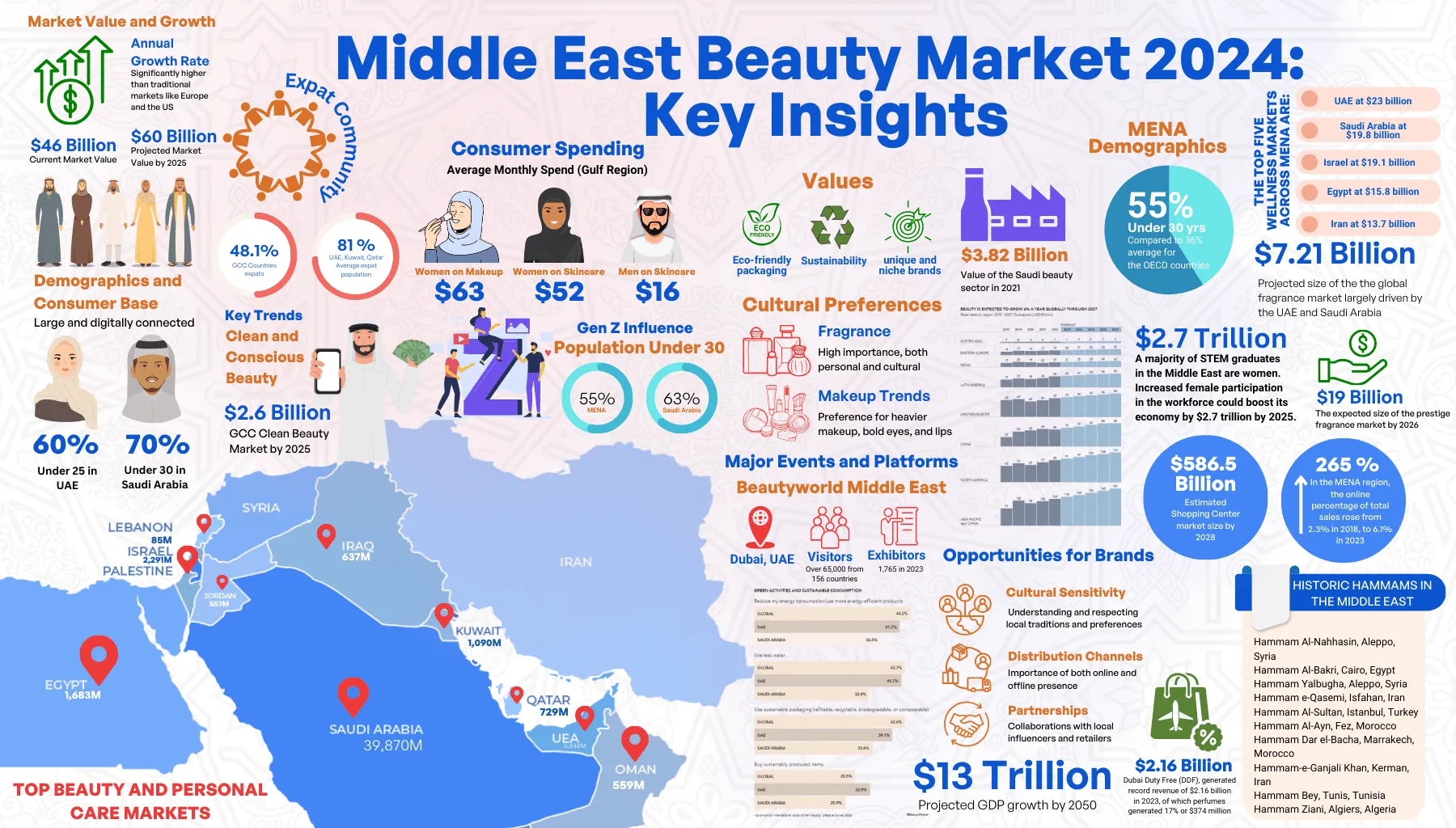TABLE OF CONTENTS
The Rich History of Middle Eastern Beauty
Evolution of Beauty Norms Through Centuries
Influence of Islamic Culture on Beauty Standards
Current Trends in the Middle East Beauty Market
Shift Towards Natural and Organic Products
Influence of Social Media on Beauty Preferences
Growth of Homegrown Beauty Companies
Popularity of Luxury Beauty Brands
Rising Demand for Halal Cosmetics
Technological Advancements in Beauty Products
Rising Beauty Awareness and Self-Care Culture
Challenges Facing the Middle East Beauty Industry
Counterfeit Products and Quality Control Issues
Cultural Sensitivities and Diverse Consumer Preferences
Regulatory Complexities Across Different Countries
Future Prospects and Opportunities
Male Grooming Market Potential
Sustainable and Eco-Friendly Beauty Solutions
Integration of AI and AR in Beauty Retail
Personalization and Customization of Beauty Products
Expansion of E-Commerce and Digital Beauty Platforms
Timeless Beauty: Exploring the Past, Present, and Future of the Middle Eastern Beauty Market 🌟
Imagine a world where beauty lasts forever. Welcome to the amazing world of Middle Eastern beauty! From the eye makeup of Cleopatra to today's modern beauty treatments, the Middle East has always been a place where beauty and self-care matter a lot. But what really makes this market so special? Let's explore the rich history, current trends, and exciting future of the Middle Eastern beauty industry.
The Rich History of Middle Eastern Beauty
The Middle East has a long history of beauty rituals that go back thousands of years. Ancient Egyptians, for instance, used kohl to line their eyes, not just to look pretty but also to protect against the harsh desert sun. Henna was another favorite, used to dye hair and create beautiful body art. Over time, beauty standards in the Middle East have changed, influenced by different cultures and historical events. The region's position at the crossroads of civilizations meant that beauty ideals were often a blend of various traditions.
Evolution of Beauty Norms Through Centuries
Traditional ingredients like argan oil, black seed oil, frankincense, and rosewater have always been important in Middle Eastern beauty practices. These ingredients are not only cosmetic but also have cultural and medicinal significance.

Influence of Islamic Culture on Beauty Standards
Islamic culture has played a significant role in shaping beauty standards in the Middle East. Modesty in appearance is highly valued, which has led to the development of unique beauty practices that align with religious principles. This includes the rise of halal cosmetics and the emphasis on natural beauty enhancement rather than dramatic transformations.
Current Trends in the Middle East Beauty Market
The beauty market in the Middle East is changing fast, driven by evolving consumer preferences and global influences. Let's explore the key trends shaping this vibrant industry.
Shift Towards Natural and Organic Products
Consumers in the Middle East are increasingly gravitating towards natural and organic beauty products. This trend is fueled by a growing awareness of ingredient safety, a desire for eco-friendly options, and a preference for traditional, plant-based remedies.
Influence of Social Media on Beauty Preferences
Social media platforms like Instagram and YouTube have become powerful influencers in the Middle Eastern beauty scene. Beauty influencers on these platforms shape trends, increase exposure to global beauty standards, and rapidly disseminate new product launches and techniques.
Growth of Homegrown Beauty Companies
Local brands are gaining traction in the Middle East beauty market by leveraging cultural knowledge and regional ingredients, catering to the specific needs of Middle Eastern consumers, and offering competitive pricing compared to international brands.
Popularity of Luxury Beauty Brands
The Middle East continues to be a strong market for luxury beauty products, driven by high disposable incomes in Gulf countries, the prestige associated with international luxury brands, and the demand for exclusive, high-end beauty experiences.
Rising Demand for Halal Cosmetics
Halal-certified beauty products are seeing significant growth as they align with religious and cultural values, ensuring product ingredients comply with Islamic principles, and expanding beyond traditional Muslim markets.
Key Drivers of Market Growth
The Middle East beauty market is experiencing significant growth, propelled by several key factors. Let's explore the main drivers behind this booming industry.
Growing Youth Population
The Middle East boasts a large and rapidly expanding youth population, which is driving demand for beauty products and services. Younger consumers are more likely to experiment with new products and trends, are typically more brand-conscious, and are willing to invest in premium beauty items. Social media influence is particularly strong among this age group, driving beauty trends.
Technological Advancements in Beauty Products
Innovation is transforming the beauty industry, with new technologies enhancing product efficacy and user experience. These include AI-powered skincare analysis tools, personalized beauty formulations, and smart beauty devices for at-home treatments.
Rising Beauty Awareness and Self-Care Culture
There's a growing emphasis on self-care and personal grooming in the Middle East. This includes an increased focus on skincare routines, growing interest in natural and organic products, and the rise of the male grooming market.
Increasing Disposable Income
As economies in the region continue to develop, consumers have more money to spend on beauty products. This has led to higher purchasing power for luxury beauty brands, a willingness to invest in professional beauty treatments, and increased spending on beauty subscriptions and services.
Challenges Facing the Middle East Beauty Industry
Despite the market's growth, the Middle East beauty industry faces several significant challenges.
Counterfeit Products and Quality Control Issues
The prevalence of counterfeit beauty products in the Middle East poses a serious threat to both consumers and legitimate brands. This issue not only affects revenue but also raises concerns about product safety and efficacy. Companies are implementing various strategies to combat this challenge, including anti-counterfeiting technology, supply chain transparency, and consumer education.
Cultural Sensitivities and Diverse Consumer Preferences
The Middle East is a region with diverse cultural backgrounds and religious practices, which significantly influence beauty standards and product preferences. Brands must carefully tailor their offerings to respect these cultural nuances while still appealing to a wide range of consumers across the region.
Regulatory Complexities Across Different Countries
The Middle East comprises multiple countries, each with its own set of regulations governing the beauty industry. This regulatory landscape presents challenges for companies looking to expand their presence in the region. To overcome these challenges, companies often need to conduct thorough market research, partner with local experts, and develop flexible product formulations and packaging.
Future Prospects and Opportunities
As the Middle East beauty market continues to evolve, several exciting prospects and opportunities are emerging on the horizon. Let's explore these potential growth areas that are set to shape the future of the industry.
Male Grooming Market Potential
The male grooming sector in the Middle East is experiencing significant growth, presenting a lucrative opportunity for beauty brands. This market is driven by increasing awareness of personal grooming among men, rising disposable incomes, and changing social norms and attitudes towards male beauty.
Sustainable and Eco-Friendly Beauty Solutions
Sustainability is becoming a crucial factor in consumer purchasing decisions. The Middle East beauty market is responding to this trend by introducing eco-friendly packaging, developing natural and organic product lines, and implementing sustainable production practices.
Integration of AI and AR in Beauty Retail
Artificial Intelligence (AI) and Augmented Reality (AR) are revolutionizing the beauty retail experience. These technologies enable virtual try-on for makeup and hair colors, AI-powered skin analysis for personalized product recommendations, and smart mirrors for interactive in-store experiences.
Personalization and Customization of Beauty Products
The demand for personalized beauty solutions is on the rise. This includes custom-blended skincare formulations, tailored haircare products based on individual hair types, and bespoke fragrances created to suit personal preferences.
Expansion of E-Commerce and Digital Beauty Platforms
The digital transformation of the beauty industry is accelerating. This includes mobile-first shopping experiences, social media-driven beauty trends and influencer collaborations, subscription-based beauty services, and online beauty consultations and virtual makeup tutorials.
Conclusion
The Middle East beauty market has undergone a remarkable transformation, evolving from traditional practices to a dynamic, innovative industry. Today, it stands as a powerhouse in the global beauty landscape, driven by factors such as increasing disposable income, a young population, and a growing interest in self-care and personal grooming. Despite challenges like regulatory hurdles and market saturation, the future of the Middle East beauty industry looks promising.
As the market continues to evolve, brands and businesses have an unprecedented opportunity to tap into this thriving sector. By embracing digital technologies, focusing on sustainability, and catering to the unique preferences of Middle Eastern consumers, companies can position themselves for success in this exciting and rapidly growing market. The Middle East beauty industry is poised for continued growth and innovation, making it an essential market for beauty enthusiasts and industry professionals alike.






.svg)

.avif)


.svg)